Overview
- Brief Narrative
- Painting of a woman bound to a large wooden post in the ground presented to former Vice President Henry A. Wallace by female French partisans when he visited the country in 1947. The painting was given to Wallace as a gift by the Union des femmes françaises (UFF) when he gave a speech at the Sorbonne in Paris, calling for international cooperation at a time of rising Cold War tensions. The UFF was a World War II resistance movement that was officially organized by a congress in December 1944 at the initiative of the French Communist Party and worked with the Front National, a major resistance organization. The UFF distributed newsletters, journals, newspapers, mounted demonstrations against restrictions, and assisted families affected by the war. Henry A. Wallace was an American agricultural business owner and politician. While in college, he invented a new strain of disease resistant corn that produced better yields. He started a business manufacturing and distributing the corn and was very successful. In 1932, he supported Franklin Delano Roosevelt’s presidential bid, and following his victory, was appointed as Roosevelt’s secretary of agriculture for eight years. He also served as vice president for Roosevelt’s third term, and later secretary of commerce for Roosevelt and then Truman.
- Date
-
received:
1947
- Geography
-
received:
Sorbonne;
Paris (France)
- Credit Line
- United States Holocaust Memorial Museum Collection, Gift of Ann Cornell
- Markings
- front, bottom, handwritten, black : To Henry Wallace / L’Union des Femmes Françaises [The Union of French Women]
- Contributor
-
Subject:
Henry A. Wallace
Subject: Union des femmes françaises
Maker: Union des femmes françaises
- Biography
-
Henry A. Wallace (1888-1965) was born in Orient, Iowa, to Henry Cantwell Wallace and May Brodhead Wallace. Henry C. served as secretary of agriculture under Warren G. Harding and Calvin Coolidge. During college, Henry A. created a strain of corn that had better disease resistance and produced better yields. He started a company manufacturing and selling his corn and became very wealthy. In 1932, he supported Franklin Delano Roosevelt’s presidential election. After Roosevelt’s win, he was appointed as secretary of agriculture and oversaw the development and creation of food stamps and school lunch programs. In 1940, Roosevelt chose Henry as his vice presidential running mate and easily won reelection. As Vice President, Henry chaired the Economic Defense Board, the Supply Priorities and Allocations Board, and the Board of Economic Warfare. He also traveled on several official international foreign relations trips serving as the president’s personal ambassador. For the 1944 election, Wallace was not chosen as Roosevelt’s running mate, but was appointed as secretary of commerce. After the war, Wallace held pacifist views and favored a conciliatory policy toward the Soviet Union. In 1948, Wallace ran as a third party presidential candidate for the Progressive Party, and after his defeat, he retired from politics. Wallace died on November 18, 1965, in Danbury, Connecticut.
The Union des femmes françaises (UFF, now known as Femmes solidaires) was created by former members of the Union des jeunes filles de France and Comité mondial des femmes contre la guerre et le fascisme after both groups were dissolved in 1939. Actions during World War II include organizing demonstrations and publishing underground newsletters. The UFF was officially organized by a congress in December 1944 at the initiative of the French Communist Party by Eugénie Cotton (1881-1967), Marie-Claude Vaillant-Couturier (1912-1996, survivor of Auschwitz and Ravensbrück), and Yvonne Dumont (1911-2002), with the participation of women’s committees active in the Resistance. Their first Congress, in June 1945, paid homage to Danielle Casanova (born Vincentelli Perini, 1909-1943), a Resistance member who was deported to Auschwitz in 1943 and died of typhus, and to Berty Albrecht (1893-1943), a member of the Resistance who died by hanging in the Fresnes prison following her arrest by the German military.
Physical Details
- Language
- English
- Classification
-
Art
- Category
-
Paintings
- Object Type
-
Painting (lcsh)
- Genre/Form
- Art.
- Physical Description
- Highly stylized painting on off white heavyweight paper with a woman in the foreground tied to a wooden pole at the waist and her hands bound together behind her. Her body is slumped over to the left, her head hangs down limply and is crowned by a circle reminiscent of a halo. The woman is shadowed in black with aqua highlighting on her head and arms, as well as on the rope, pole, and the black and brown ground beneath her. What appears to be a pale tan and red brick building stands in the background to the right, and to the left are two long, thin, black smokestacks rising up from four low, black buildings. The sky is light blue with red shading over the horizon. There are two paint blemishes near the smokestacks.
- Dimensions
- overall: Height: 12.875 inches (32.703 cm) | Width: 9.500 inches (24.13 cm)
- Materials
- overall : paper, paint
Rights & Restrictions
- Conditions on Access
- No restrictions on access
- Conditions on Use
- Restrictions on use. Copyright status unknown.
Keywords & Subjects
- Topical Term
- Holocaust, Jewish (1939-1945)--Jewish resistance. World War, 1939-1945. World War, 1939-1945--Participation, Female. Politicians--United States. Jewish Women -- Associations, institutions, etc.
- Geographic Name
- France.
- Personal Name
- Wallace, Henry A. (Henry Agard), 1888-1965.
- Corporate Name
- Front national (France : 1941-1945)
Administrative Notes
- Legal Status
- Permanent Collection
- Provenance
- The painting was donated to the United States Holocaust Memorial Museum in 2017 by Ann Cornell, the granddaughter of Henry A. Wallace.
- Record last modified:
- 2023-07-05 08:31:12
- This page:
- https://collections.ushmm.org/search/catalog/irn563218
Download & Licensing
In-Person Research
- By Appointment
- Request 21 Days in Advance of Visit
- Plan a Research Visit
- Request to See This Object
Contact Us
Also in Vice President Henry A. Wallace collection
The collection consists of a briefcase, two ribbons, a stamp, two portfolios of handmade miniature textiles, documents, artwork, books, photographs, and fliers relating to the French Resistance during WWII and presented to former Vice President Henry A. Wallace in France after the Holocaust.
Date: 1940-1947
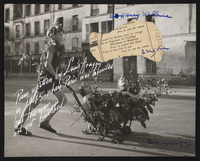
Union des femmes françaises portfolio
Document
The collection contains a portfolio of documents, fliers, leaflets, newsletters, photographs, and publications collected by a group of former partisans called the Union des Femmes Françaises and presented to Vice President Henry A. Wallace during a trip he made to France in April 1947. The collected materials were presented to him as mementos of the French Resistance during World War II, and wrapped in ribbon in a small Hermes suitcase. Also includes two poems by Louis Aragon and Paul Eluard; a letter and photograph of Jacqueline Quatremaire, a woman who was imprisoned in the Fort de Romainville concentration camp and deported to the Auschwitz concentration camp where she perished; publications about French Resistance fighters France Bloch-Sérazin and Danielle Casanova; a prisoner prayer book; and a 1943 illegally published copy of Laurent Daniel’s Les amants d’Avignon. Many materials include cards with personal inscriptions to Wallace regarding the item.
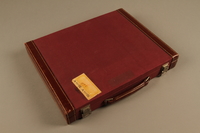
Burgundy Hermès briefcase given to former Vice President Henry A. Wallace by female French partisans
Object
Hermès briefcase presented to former Vice President Henry A. Wallace by female French partisans when he visited the country in 1947. The briefcase was made by the French brand Hermès, a high end luxury goods manufacturer. The case was given to Wallace as a gift by the Union des femmes françaises (UFF) when he gave a speech at the Sorbonne in Paris, calling for international cooperation at a time of rising Cold War tensions. The UFF was a World War II resistance movement that was officially organized by a congress in December 1944 at the initiative of the French Communist Party and worked with the Front National, a major resistance organization. The UFF distributed newsletters, journals, newspapers, mounted demonstrations against restrictions, and assisted families affected by the war. Henry A. Wallace was an American agricultural business owner and politician. While in college, he invented a new strain of disease resistant corn that produced better yields. He started a business manufacturing and distributing the corn and was very successful. In 1932, he supported Franklin Delano Roosevelt’s presidential bid and following his victory, was appointed as Roosevelt’s secretary of agriculture for eight years. He also served as vice president for Roosevelt’s third term, and later, secretary of commerce for Roosevelt and then Truman.
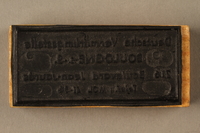
Text only German exchange hand stamp given to former Vice President Henry A. Wallace by female French partisans
Object
German exchange hand stamp presented to former Vice President Henry A. Wallace by female French partisans when he visited the country in 1947. The stamp was given to Wallace as a gift by the Union des femmes françaises (UFF) when he gave a speech at the Sorbonne in Paris, calling for international cooperation at a time of rising Cold War tensions. The UFF was a World War II resistance movement that was officially organized by a congress in December 1944, at the initiative of the French Communist Party and worked with the Front National, a major resistance organization. The UFF distributed newsletters, journals, newspapers, mounted demonstrations against restrictions, and assisted families affected by the war. Henry A. Wallace was an American agricultural business owner and politician. While in college, he invented a new strain of disease resistant corn that produced better yields. He started a business manufacturing and distributing the corn and was very successful. In 1932, he supported Franklin Delano Roosevelt’s presidential bid, and following his victory, was appointed as Roosevelt’s secretary of agriculture for eight years. He also served as vice president for Roosevelt’s third term, and later secretary of commerce for Roosevelt and then Truman.
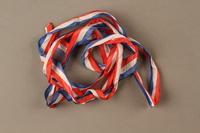
Red, white and blue ribbon given to former Vice President Henry A. Wallace by female French partisans
Object
Red, white, and blue striped ribbon presented to former Vice President Henry A. Wallace by female French partisans when he visited the country in 1947. The ribbon was given to Wallace as a gift by the Union des femmes françaises (UFF) when he gave a speech at the Sorbonne in Paris, calling for international cooperation at a time of rising Cold War tensions. The UFF was a World War II resistance movement that was officially organized by a congress in December 1944, at the initiative of the French Communist Party and worked with the Front National, a major resistance organization. The UFF distributed newsletters, journals, newspapers, mounted demonstrations against restrictions, and assisted families affected by the war. Henry A. Wallace was an American agricultural business owner and politician. While in college, he invented a new strain of disease resistant corn that produced better yields. He started a business manufacturing and distributing the corn and was very successful. In 1932, he supported Franklin Delano Roosevelt’s presidential bid, and following his victory, was appointed as Roosevelt’s secretary of agriculture for eight years. He also served as vice president for Roosevelt’s third term, and later secretary of commerce for Roosevelt and then Truman.
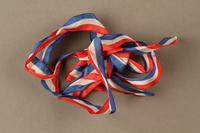
Red white and blue ribbon with the ends tied together given to former Vice President Henry A. Wallace by female French partisans
Object
Red, white, and blue ribbon presented to former Vice President Henry A. Wallace by female French partisans when he visited the country in 1947. The ribbon was given to Wallace as a gift by the Union des femmes françaises (UFF) when he gave a speech at the Sorbonne in Paris, calling for international cooperation at a time of rising Cold War tensions. The UFF was a World War II resistance movement that was officially organized by a congress in December 1944, at the initiative of the French Communist Party and worked with the Front National, a major resistance organization. The UFF distributed newsletters, journals, newspapers, mounted demonstrations against restrictions, and assisted families affected by the war. Henry A. Wallace was an American agricultural business owner and politician. While in college, he invented a new strain of disease resistant corn that produced better yields. He started a business manufacturing and distributing the corn and was very successful. In 1932, he supported Franklin Delano Roosevelt’s presidential bid, and following his victory, was appointed as Roosevelt’s secretary of agriculture for eight years. He also served as vice president for Roosevelt’s third term, and later secretary of commerce for Roosevelt and then Truman.
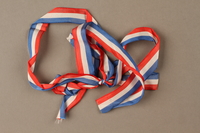
Red white and blue ribbon with the ends tied together given to former Vice President Henry A. Wallace by female French partisans
Object
Red, white, and blue ribbon presented to former Vice President Henry A. Wallace by female French partisans when he visited the country in 1947. The ribbon was given to Wallace as a gift by the Union des femmes françaises (UFF) when he gave a speech at the Sorbonne in Paris, calling for international cooperation at a time of rising Cold War tensions. The UFF was a World War II resistance movement that was officially organized by a congress in December 1944, at the initiative of the French Communist Party and worked with the Front National, a major resistance organization. The UFF distributed newsletters, journals, newspapers, mounted demonstrations against restrictions, and assisted families affected by the war. Henry A. Wallace was an American agricultural business owner and politician. While in college, he invented a new strain of disease resistant corn that produced better yields. He started a business manufacturing and distributing the corn and was very successful. In 1932, he supported Franklin Delano Roosevelt’s presidential bid, and following his victory, was appointed as Roosevelt’s secretary of agriculture for eight years. He also served as vice president for Roosevelt’s third term, and later secretary of commerce for Roosevelt and then Truman.
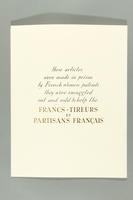
Portfolio of handmade French Resistance mementos given to former Vice President Henry A. Wallace by female French partisans
Object
Portfolio containing handmade cloth trinkets presented to former Vice President Henry A. Wallace by female French partisans when he visited the country in 1947. The portfolio was given to Wallace as a gift by the Union des femmes françaises (UFF) when he gave a speech at the Sorbonne in Paris, calling for international cooperation at a time of rising Cold War tensions. The UFF was a World War II resistance movement that was officially organized by a congress in December 1944, at the initiative of the French Communist Party and worked with the Front National, a major resistance organization. The UFF distributed newsletters, journals, newspapers, mounted demonstrations against restrictions, and assisted families affected by the war. Henry A. Wallace was an American agricultural business owner and politician. While in college, he invented a new strain of disease resistant corn that produced better yields. He started a business manufacturing and distributing the corn and was very successful. In 1932, he supported Franklin Delano Roosevelt’s presidential bid, and following his victory, was appointed as Roosevelt’s secretary of agriculture for eight years. He also served as vice president for Roosevelt’s third term, and later secretary of commerce for Roosevelt and then Truman.
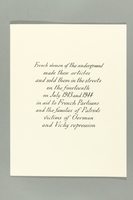
Portfolio of French Resistance mementos given to former Vice President Henry A. Wallace by female French partisans
Object
Portfolio containing handmade cloth trinkets presented to former Vice President Henry A. Wallace by female French partisans when he visited the country in 1947. The portfolio was given to Wallace as a gift by the Union des femmes françaises (UFF) when he gave a speech at the Sorbonne in Paris, calling for international cooperation at a time of rising Cold War tensions. The UFF was a World War II resistance movement that was officially organized by a congress in December 1944, at the initiative of the French Communist Party and worked with the Front National, a major resistance organization. The UFF distributed newsletters, journals, newspapers, mounted demonstrations against restrictions, and assisted families affected by the war. Henry A. Wallace was an American agricultural business owner and politician. While in college, he invented a new strain of disease resistant corn that produced better yields. He started a business manufacturing and distributing the corn and was very successful. In 1932, he supported Franklin Delano Roosevelt’s presidential bid, and following his victory, was appointed as Roosevelt’s secretary of agriculture for eight years. He also served as vice president for Roosevelt’s third term, and later secretary of commerce for Roosevelt and then Truman.



